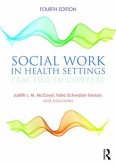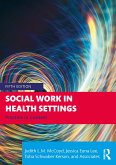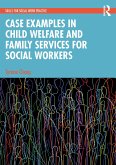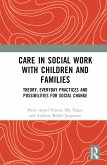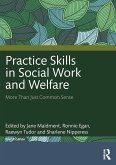Judith L.M. McCoyd, Jessica Euna Lee, Toba Schwaber Kerson
Social Work in Health Settings
Practice in Context
Judith L.M. McCoyd, Jessica Euna Lee, Toba Schwaber Kerson
Social Work in Health Settings
Practice in Context
- Gebundenes Buch
- Merkliste
- Auf die Merkliste
- Bewerten Bewerten
- Teilen
- Produkt teilen
- Produkterinnerung
- Produkterinnerung
This fully revised and expanded fifth edition of Social Work in Health Settings: Practice in Context maintains its use of the Practice in Context (PiC) decision-making framework to explore a wide range of social work services in health care settings.
Andere Kunden interessierten sich auch für
![Social Work in Health Settings Social Work in Health Settings]() Judith L.M. McCoydSocial Work in Health Settings84,99 €
Judith L.M. McCoydSocial Work in Health Settings84,99 €![Social Work in Health Settings Social Work in Health Settings]() Judith L.M. McCoydSocial Work in Health Settings61,99 €
Judith L.M. McCoydSocial Work in Health Settings61,99 €![Case Examples in Child Welfare and Family Services for Social Workers Case Examples in Child Welfare and Family Services for Social Workers]() Tyrone ChengCase Examples in Child Welfare and Family Services for Social Workers176,99 €
Tyrone ChengCase Examples in Child Welfare and Family Services for Social Workers176,99 €![Case Examples in Child Welfare and Family Services for Social Workers Case Examples in Child Welfare and Family Services for Social Workers]() Tyrone ChengCase Examples in Child Welfare and Family Services for Social Workers35,99 €
Tyrone ChengCase Examples in Child Welfare and Family Services for Social Workers35,99 €![Research and Research Methods for Youth Practitioners Research and Research Methods for Youth Practitioners]() Research and Research Methods for Youth Practitioners58,99 €
Research and Research Methods for Youth Practitioners58,99 €![Care in Social Work with Children and Families Care in Social Work with Children and Families]() Maria Appel NissenCare in Social Work with Children and Families176,99 €
Maria Appel NissenCare in Social Work with Children and Families176,99 €![Practice Skills in Social Work and Welfare Practice Skills in Social Work and Welfare]() Practice Skills in Social Work and Welfare54,99 €
Practice Skills in Social Work and Welfare54,99 €-
-
-
This fully revised and expanded fifth edition of Social Work in Health Settings: Practice in Context maintains its use of the Practice in Context (PiC) decision-making framework to explore a wide range of social work services in health care settings.
Hinweis: Dieser Artikel kann nur an eine deutsche Lieferadresse ausgeliefert werden.
Hinweis: Dieser Artikel kann nur an eine deutsche Lieferadresse ausgeliefert werden.
Produktdetails
- Produktdetails
- Verlag: Taylor & Francis Ltd
- 5 ed
- Seitenzahl: 490
- Erscheinungstermin: 27. Dezember 2022
- Englisch
- Abmessung: 253mm x 181mm x 33mm
- Gewicht: 1016g
- ISBN-13: 9781032186634
- ISBN-10: 1032186631
- Artikelnr.: 65610677
- Herstellerkennzeichnung
- Libri GmbH
- Europaallee 1
- 36244 Bad Hersfeld
- gpsr@libri.de
- Verlag: Taylor & Francis Ltd
- 5 ed
- Seitenzahl: 490
- Erscheinungstermin: 27. Dezember 2022
- Englisch
- Abmessung: 253mm x 181mm x 33mm
- Gewicht: 1016g
- ISBN-13: 9781032186634
- ISBN-10: 1032186631
- Artikelnr.: 65610677
- Herstellerkennzeichnung
- Libri GmbH
- Europaallee 1
- 36244 Bad Hersfeld
- gpsr@libri.de
Judith L.M. McCoyd, PhD, LCSW is an Associate Professor at Rutgers University School of Social Work, having served as a health social worker in perinatal, oncology, and emergency room settings in the 1980s through the early 2000s. Her research and practice lie at the intersection of physical and mental health, loss and grief, and interprofessional collaboration. Jessica Euna Lee, PhD, LSW is an Assistant Professor at Indiana University School of Social Work, having practiced as a health social worker with refugee and immigrant communities. Her research and practice focus on refugee and global health, health equity, ethics, forced migration, decolonizing practices, and community-driven interventions. Toba Schwaber Kerson, DSW, PhD is Mary Hale Chase Professor Emeritus in Social Sciences and Social Work and Social Research at Bryn Mawr College. As a Fulbright Specialist, she has lectured and consulted about social work in public health at Hebrew University in Jerusalem, Israel, and the French Social Work Training Institute in Marseille, France. In retirement, Professor Kerson continues to follow her passions for social work, public health, and civic responsibility.
0.Foreword. 1.Practice-in-Context (PiC): The Framework. Part One -
Individual and Family Work in Health Settings. 2.Primer on micro practice
in social work in health care: Context, skills, interventions, and best
practices. Section 1.1 - Perinatal health settings. 3.Navigating the
unexpected: When maternal trauma and birth intersect. 4.Ethical
considerations in fetal surgery: Social workers' role determining
maternal-fetal surgery eligibility given an addiction history. Section 1.2
- Children and Youth. 5.Amelia's big changes embodied: Cyclic vomiting
syndrome or somatization. 6.Pediatric rare conditions: Working with
families through diagnosis and living with illness. 7.Leadership Education
in Neurodevelopmental Disabilities Program (LEND): Interprofessional work
supporting rural and urban children with neuro-developmental disabilities.
8.Sam's "hatching" process: Care management for a child with gender
dysphoria. Section 1.3 - Emerging Adults. 9.Carter's struggles with an
eating disorder and suicidality: Navigating eating disorder treatment
spaces as a queer, mixed-race adolescent. 10.Assistive technology and
developmental disability: Helping Gina find her voice. 11.Enhancing the
psychosocial and sexual well-being of gender-diverse young adults within a
multidisciplinary clinic. Section 1.4 - Adults. 12.Working with
undocumented immigrants: Creative problem-solving when serious illness
intersects with no insurance. 13.When oncology and psychosocial issues
clash: A social worker's role in a complex case with multiple barriers to
care. 14.Social work practice adapts to liver transplant population shifts.
15.A functional medicine approach for complex war-related illnesses:
Interprofessional teams creating benefits for personalized veteran care.
16.Smoking cessation as a social justice issue: Robert's struggles to stop
smoking. Section 1.5 - Older adulthood. 17.Competing interests: Upholding
social work ethics in the for-profit dialysis setting. 18.Working with
Junior: A study of collaboration, boundaries, and use of self. 19.Social
work in long-term care and rehabilitation settings for older adults.
20.Joan's hold on independence: A case of safety and self-determination.
21.Should Grandma be living by herself? The challenges of older adults with
mild cognitive impairment in rural communities. 22.A good death: Accessing
care at the end of life-cultural, clinical, and institutional
considerations. Part Two - Program, Policy, and Public Health Social Work.
23.Primer on macro practice in social work in health care: Public health
social work. Section 2.1 - Spanning boundaries across micro to macro
practice. 24.Supervision: A micro through macro form of practice in health
care. 25.The role of school in healthcare intervention: The benefit of
daily monitoring, teamwork, and data collection. Section 2.2 - Programmatic
responses to public health needs. 26.Prenatal social support for
underserved women in an inner-city community. 27.Social work support for
medical students: The creation of a Wellness Advisory Program. Section 2.3
- Policy responses to public health needs. 28.Contact tracing: public
health in unprecedented times. 29.Dentistry & HIV positive patients:
Indiana University School of Dentistry, social work team.
30.Community-based health interventions and peer support for Bhutanese
refugees. Section 2.4 - Summary. 31.Conclusion.
Individual and Family Work in Health Settings. 2.Primer on micro practice
in social work in health care: Context, skills, interventions, and best
practices. Section 1.1 - Perinatal health settings. 3.Navigating the
unexpected: When maternal trauma and birth intersect. 4.Ethical
considerations in fetal surgery: Social workers' role determining
maternal-fetal surgery eligibility given an addiction history. Section 1.2
- Children and Youth. 5.Amelia's big changes embodied: Cyclic vomiting
syndrome or somatization. 6.Pediatric rare conditions: Working with
families through diagnosis and living with illness. 7.Leadership Education
in Neurodevelopmental Disabilities Program (LEND): Interprofessional work
supporting rural and urban children with neuro-developmental disabilities.
8.Sam's "hatching" process: Care management for a child with gender
dysphoria. Section 1.3 - Emerging Adults. 9.Carter's struggles with an
eating disorder and suicidality: Navigating eating disorder treatment
spaces as a queer, mixed-race adolescent. 10.Assistive technology and
developmental disability: Helping Gina find her voice. 11.Enhancing the
psychosocial and sexual well-being of gender-diverse young adults within a
multidisciplinary clinic. Section 1.4 - Adults. 12.Working with
undocumented immigrants: Creative problem-solving when serious illness
intersects with no insurance. 13.When oncology and psychosocial issues
clash: A social worker's role in a complex case with multiple barriers to
care. 14.Social work practice adapts to liver transplant population shifts.
15.A functional medicine approach for complex war-related illnesses:
Interprofessional teams creating benefits for personalized veteran care.
16.Smoking cessation as a social justice issue: Robert's struggles to stop
smoking. Section 1.5 - Older adulthood. 17.Competing interests: Upholding
social work ethics in the for-profit dialysis setting. 18.Working with
Junior: A study of collaboration, boundaries, and use of self. 19.Social
work in long-term care and rehabilitation settings for older adults.
20.Joan's hold on independence: A case of safety and self-determination.
21.Should Grandma be living by herself? The challenges of older adults with
mild cognitive impairment in rural communities. 22.A good death: Accessing
care at the end of life-cultural, clinical, and institutional
considerations. Part Two - Program, Policy, and Public Health Social Work.
23.Primer on macro practice in social work in health care: Public health
social work. Section 2.1 - Spanning boundaries across micro to macro
practice. 24.Supervision: A micro through macro form of practice in health
care. 25.The role of school in healthcare intervention: The benefit of
daily monitoring, teamwork, and data collection. Section 2.2 - Programmatic
responses to public health needs. 26.Prenatal social support for
underserved women in an inner-city community. 27.Social work support for
medical students: The creation of a Wellness Advisory Program. Section 2.3
- Policy responses to public health needs. 28.Contact tracing: public
health in unprecedented times. 29.Dentistry & HIV positive patients:
Indiana University School of Dentistry, social work team.
30.Community-based health interventions and peer support for Bhutanese
refugees. Section 2.4 - Summary. 31.Conclusion.
0.Foreword. 1.Practice-in-Context (PiC): The Framework. Part One - Individual and Family Work in Health Settings. 2.Primer on micro practice in social work in health care: Context, skills, interventions, and best practices. Section 1.1 - Perinatal health settings. 3.Navigating the unexpected: When maternal trauma and birth intersect. 4.Ethical considerations in fetal surgery: Social workers' role determining maternal-fetal surgery eligibility given an addiction history. Section 1.2 - Children and Youth. 5.Amelia's big changes embodied: Cyclic vomiting syndrome or somatization. 6.Pediatric rare conditions: Working with families through diagnosis and living with illness. 7.Leadership Education in Neurodevelopmental Disabilities Program (LEND): Interprofessional work supporting rural and urban children with neuro-developmental disabilities. 8.Sam's "hatching" process: Care management for a child with gender dysphoria. Section 1.3 - Emerging Adults. 9.Carter's struggles with an eating disorder and suicidality: Navigating eating disorder treatment spaces as a queer, mixed-race adolescent. 10.Assistive technology and developmental disability: Helping Gina find her voice. 11.Enhancing the psychosocial and sexual well-being of gender-diverse young adults within a multidisciplinary clinic. Section 1.4 - Adults. 12.Working with undocumented immigrants: Creative problem-solving when serious illness intersects with no insurance. 13.When oncology and psychosocial issues clash: A social worker's role in a complex case with multiple barriers to care. 14.Social work practice adapts to liver transplant population shifts. 15.A functional medicine approach for complex war-related illnesses: Interprofessional teams creating benefits for personalized veteran care. 16.Smoking cessation as a social justice issue: Robert's struggles to stop smoking. Section 1.5 - Older adulthood. 17.Competing interests: Upholding social work ethics in the for-profit dialysis setting. 18.Working with Junior: A study of collaboration, boundaries, and use of self. 19.Social work in long-term care and rehabilitation settings for older adults. 20.Joan's hold on independence: A case of safety and self-determination. 21.Should Grandma be living by herself? The challenges of older adults with mild cognitive impairment in rural communities. 22.A good death: Accessing care at the end of life-cultural, clinical, and institutional considerations. Part Two - Program, Policy, and Public Health Social Work. 23.Primer on macro practice in social work in health care: Public health social work. Section 2.1 - Spanning boundaries across micro to macro practice. 24.Supervision: A micro through macro form of practice in health care. 25.The role of school in healthcare intervention: The benefit of daily monitoring, teamwork, and data collection. Section 2.2 - Programmatic responses to public health needs. 26.Prenatal social support for underserved women in an inner-city community. 27.Social work support for medical students: The creation of a Wellness Advisory Program. Section 2.3 - Policy responses to public health needs. 28.Contact tracing: public health in unprecedented times. 29.Dentistry & HIV positive patients: Indiana University School of Dentistry, social work team. 30.Community-based health interventions and peer support for Bhutanese refugees. Section 2.4 - Summary. 31.Conclusion.
0.Foreword. 1.Practice-in-Context (PiC): The Framework. Part One -
Individual and Family Work in Health Settings. 2.Primer on micro practice
in social work in health care: Context, skills, interventions, and best
practices. Section 1.1 - Perinatal health settings. 3.Navigating the
unexpected: When maternal trauma and birth intersect. 4.Ethical
considerations in fetal surgery: Social workers' role determining
maternal-fetal surgery eligibility given an addiction history. Section 1.2
- Children and Youth. 5.Amelia's big changes embodied: Cyclic vomiting
syndrome or somatization. 6.Pediatric rare conditions: Working with
families through diagnosis and living with illness. 7.Leadership Education
in Neurodevelopmental Disabilities Program (LEND): Interprofessional work
supporting rural and urban children with neuro-developmental disabilities.
8.Sam's "hatching" process: Care management for a child with gender
dysphoria. Section 1.3 - Emerging Adults. 9.Carter's struggles with an
eating disorder and suicidality: Navigating eating disorder treatment
spaces as a queer, mixed-race adolescent. 10.Assistive technology and
developmental disability: Helping Gina find her voice. 11.Enhancing the
psychosocial and sexual well-being of gender-diverse young adults within a
multidisciplinary clinic. Section 1.4 - Adults. 12.Working with
undocumented immigrants: Creative problem-solving when serious illness
intersects with no insurance. 13.When oncology and psychosocial issues
clash: A social worker's role in a complex case with multiple barriers to
care. 14.Social work practice adapts to liver transplant population shifts.
15.A functional medicine approach for complex war-related illnesses:
Interprofessional teams creating benefits for personalized veteran care.
16.Smoking cessation as a social justice issue: Robert's struggles to stop
smoking. Section 1.5 - Older adulthood. 17.Competing interests: Upholding
social work ethics in the for-profit dialysis setting. 18.Working with
Junior: A study of collaboration, boundaries, and use of self. 19.Social
work in long-term care and rehabilitation settings for older adults.
20.Joan's hold on independence: A case of safety and self-determination.
21.Should Grandma be living by herself? The challenges of older adults with
mild cognitive impairment in rural communities. 22.A good death: Accessing
care at the end of life-cultural, clinical, and institutional
considerations. Part Two - Program, Policy, and Public Health Social Work.
23.Primer on macro practice in social work in health care: Public health
social work. Section 2.1 - Spanning boundaries across micro to macro
practice. 24.Supervision: A micro through macro form of practice in health
care. 25.The role of school in healthcare intervention: The benefit of
daily monitoring, teamwork, and data collection. Section 2.2 - Programmatic
responses to public health needs. 26.Prenatal social support for
underserved women in an inner-city community. 27.Social work support for
medical students: The creation of a Wellness Advisory Program. Section 2.3
- Policy responses to public health needs. 28.Contact tracing: public
health in unprecedented times. 29.Dentistry & HIV positive patients:
Indiana University School of Dentistry, social work team.
30.Community-based health interventions and peer support for Bhutanese
refugees. Section 2.4 - Summary. 31.Conclusion.
Individual and Family Work in Health Settings. 2.Primer on micro practice
in social work in health care: Context, skills, interventions, and best
practices. Section 1.1 - Perinatal health settings. 3.Navigating the
unexpected: When maternal trauma and birth intersect. 4.Ethical
considerations in fetal surgery: Social workers' role determining
maternal-fetal surgery eligibility given an addiction history. Section 1.2
- Children and Youth. 5.Amelia's big changes embodied: Cyclic vomiting
syndrome or somatization. 6.Pediatric rare conditions: Working with
families through diagnosis and living with illness. 7.Leadership Education
in Neurodevelopmental Disabilities Program (LEND): Interprofessional work
supporting rural and urban children with neuro-developmental disabilities.
8.Sam's "hatching" process: Care management for a child with gender
dysphoria. Section 1.3 - Emerging Adults. 9.Carter's struggles with an
eating disorder and suicidality: Navigating eating disorder treatment
spaces as a queer, mixed-race adolescent. 10.Assistive technology and
developmental disability: Helping Gina find her voice. 11.Enhancing the
psychosocial and sexual well-being of gender-diverse young adults within a
multidisciplinary clinic. Section 1.4 - Adults. 12.Working with
undocumented immigrants: Creative problem-solving when serious illness
intersects with no insurance. 13.When oncology and psychosocial issues
clash: A social worker's role in a complex case with multiple barriers to
care. 14.Social work practice adapts to liver transplant population shifts.
15.A functional medicine approach for complex war-related illnesses:
Interprofessional teams creating benefits for personalized veteran care.
16.Smoking cessation as a social justice issue: Robert's struggles to stop
smoking. Section 1.5 - Older adulthood. 17.Competing interests: Upholding
social work ethics in the for-profit dialysis setting. 18.Working with
Junior: A study of collaboration, boundaries, and use of self. 19.Social
work in long-term care and rehabilitation settings for older adults.
20.Joan's hold on independence: A case of safety and self-determination.
21.Should Grandma be living by herself? The challenges of older adults with
mild cognitive impairment in rural communities. 22.A good death: Accessing
care at the end of life-cultural, clinical, and institutional
considerations. Part Two - Program, Policy, and Public Health Social Work.
23.Primer on macro practice in social work in health care: Public health
social work. Section 2.1 - Spanning boundaries across micro to macro
practice. 24.Supervision: A micro through macro form of practice in health
care. 25.The role of school in healthcare intervention: The benefit of
daily monitoring, teamwork, and data collection. Section 2.2 - Programmatic
responses to public health needs. 26.Prenatal social support for
underserved women in an inner-city community. 27.Social work support for
medical students: The creation of a Wellness Advisory Program. Section 2.3
- Policy responses to public health needs. 28.Contact tracing: public
health in unprecedented times. 29.Dentistry & HIV positive patients:
Indiana University School of Dentistry, social work team.
30.Community-based health interventions and peer support for Bhutanese
refugees. Section 2.4 - Summary. 31.Conclusion.
0.Foreword. 1.Practice-in-Context (PiC): The Framework. Part One - Individual and Family Work in Health Settings. 2.Primer on micro practice in social work in health care: Context, skills, interventions, and best practices. Section 1.1 - Perinatal health settings. 3.Navigating the unexpected: When maternal trauma and birth intersect. 4.Ethical considerations in fetal surgery: Social workers' role determining maternal-fetal surgery eligibility given an addiction history. Section 1.2 - Children and Youth. 5.Amelia's big changes embodied: Cyclic vomiting syndrome or somatization. 6.Pediatric rare conditions: Working with families through diagnosis and living with illness. 7.Leadership Education in Neurodevelopmental Disabilities Program (LEND): Interprofessional work supporting rural and urban children with neuro-developmental disabilities. 8.Sam's "hatching" process: Care management for a child with gender dysphoria. Section 1.3 - Emerging Adults. 9.Carter's struggles with an eating disorder and suicidality: Navigating eating disorder treatment spaces as a queer, mixed-race adolescent. 10.Assistive technology and developmental disability: Helping Gina find her voice. 11.Enhancing the psychosocial and sexual well-being of gender-diverse young adults within a multidisciplinary clinic. Section 1.4 - Adults. 12.Working with undocumented immigrants: Creative problem-solving when serious illness intersects with no insurance. 13.When oncology and psychosocial issues clash: A social worker's role in a complex case with multiple barriers to care. 14.Social work practice adapts to liver transplant population shifts. 15.A functional medicine approach for complex war-related illnesses: Interprofessional teams creating benefits for personalized veteran care. 16.Smoking cessation as a social justice issue: Robert's struggles to stop smoking. Section 1.5 - Older adulthood. 17.Competing interests: Upholding social work ethics in the for-profit dialysis setting. 18.Working with Junior: A study of collaboration, boundaries, and use of self. 19.Social work in long-term care and rehabilitation settings for older adults. 20.Joan's hold on independence: A case of safety and self-determination. 21.Should Grandma be living by herself? The challenges of older adults with mild cognitive impairment in rural communities. 22.A good death: Accessing care at the end of life-cultural, clinical, and institutional considerations. Part Two - Program, Policy, and Public Health Social Work. 23.Primer on macro practice in social work in health care: Public health social work. Section 2.1 - Spanning boundaries across micro to macro practice. 24.Supervision: A micro through macro form of practice in health care. 25.The role of school in healthcare intervention: The benefit of daily monitoring, teamwork, and data collection. Section 2.2 - Programmatic responses to public health needs. 26.Prenatal social support for underserved women in an inner-city community. 27.Social work support for medical students: The creation of a Wellness Advisory Program. Section 2.3 - Policy responses to public health needs. 28.Contact tracing: public health in unprecedented times. 29.Dentistry & HIV positive patients: Indiana University School of Dentistry, social work team. 30.Community-based health interventions and peer support for Bhutanese refugees. Section 2.4 - Summary. 31.Conclusion.


